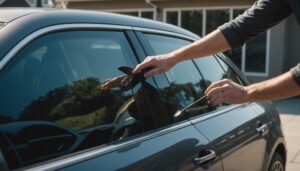Did you know that over 50% of car owners consider window tinting for added comfort and protection? The cost to tint car windows can vary considerably, influenced by factors like the type of film and vehicle size. If you’re contemplating this upgrade, you’ll want to understand not just the initial expenses but also the long-term benefits and maintenance involved. Let’s explore what shapes these costs and how to get the best value.
Key Takeaways
- Car window tinting costs generally range from $100 to $400, depending on film type and vehicle size.
- Larger vehicles, like SUVs or vans, typically incur higher tinting costs than smaller cars.
- Professional installation, offering warranties and better results, usually costs between $200 and $600.
- DIY options are available for $50 to $200 but come with risks like bubbles and peeling.
- Prices can vary regionally, so shopping around for the best deal is advisable.
Factors Influencing Window Tinting Costs

When you’re considering window tinting for your car, several factors can influence the overall cost. First, think about the size and type of your vehicle. Larger cars with more windows will generally cost more to tint. The complexity of your vehicle’s make and model also plays a role; curved or intricate windows require more labor and skill, which can hike up the price.
Next, consider the quality of the tint film. Higher-end films typically come with better warranties and UV protection, resulting in a higher initial investment. Installation labor is another significant factor; experienced technicians often charge more but can deliver a flawless finish. Additionally, local regulations regarding the legality of tint darkness and reflective properties can affect your choices and costs. Consequently, evaluating these aspects will guarantee you make an informed decision while budgeting for your window tinting.
Types of Window Tint Film

Understanding the various types of window tint film is essential for making an informed choice that fits both your aesthetic and functional needs. There are several options available, each with unique characteristics.
Dyed film offers a sleek look and blocks heat, while allowing some light to pass through. Metalized film enhances durability and reflects heat effectively but may interfere with signals for GPS and cell phones. Ceramic film is a top-tier option, providing excellent heat rejection and UV protection without signal disruption.
Finally, hybrid films combine elements from both dyed and metalized films, balancing cost and performance. Consider your vehicle’s purpose, local regulations, and personal preferences when choosing the right film. Each type comes with distinct benefits and drawbacks, so weigh your options carefully to find what works best for you and your car.
Average Cost of Car Window Tinting

Car window tinting typically ranges from $100 to $400, depending on various factors like the type of film, the size of your vehicle, and labor costs in your area. For instance, if you choose a premium ceramic film, you might find yourself on the higher end of that spectrum. The size of your vehicle also plays an essential role; larger SUVs or vans generally cost more to tint than smaller cars.
Additionally, regional differences can impact the overall price. Urban areas with higher labor costs often lead to higher tinting prices. It’s also worth noting that some shops may offer package deals or discounts, so it’s wise to shop around. Ultimately, understanding these factors helps you make informed decisions when considering window tinting for your vehicle. A little research can guarantee you get the right tint at a fair price, giving you both value and protection.
DIY Vs Professional Tinting: Cost Comparison
Is it worth diving into a DIY approach for tinting your car windows, or should you opt for professional help? When weighing costs, DIY tinting might seem appealing, ranging from $50 to $200 for materials. You’ll need to purchase window film, tools, and possibly a heat gun. However, consider your skill level—poor application can result in bubbles, peeling, or legal issues due to tinting violations.
On the other hand, hiring a professional typically costs between $200 and $600, depending on the complexity of your vehicle and the quality of the film. Professionals bring expertise and often provide warranties, which can save you money in the long run if repairs are needed.
Ultimately, if you’re confident in your abilities and happy to invest time, DIY may work for you. But for a flawless finish and peace of mind, professional tinting could be worth the extra cost.
Benefits of Window Tinting
Choosing between DIY and professional tinting opens up a discussion about the benefits window tinting offers. First, it enhances your vehicle’s appearance, giving it a sleek, polished look. More importantly, it provides UV protection, blocking up to 99% of harmful rays and reducing the risk of skin cancer. This also means less interior fading, helping maintain your car’s value over time.
Additionally, window tinting improves privacy, making it harder for prying eyes to see inside your vehicle. This not only protects your belongings but also gives you a sense of security. You’ll also notice a significant reduction in heat. Tinted windows keep your car cooler on hot days, which can lead to more comfortable drives and less reliance on air conditioning, ultimately saving you money on fuel.
Additional Costs to Consider
Before diving into the decision of tinting your car windows, it’s essential to contemplate additional costs that may arise. While the initial tinting cost is often the focus, you might encounter other financial factors that can impact your overall budget.
Here’s a breakdown of potential additional costs:
| Cost Item | Estimated Amount |
|---|---|
| Removal of Old Tint | $50 – $150 |
| Legal Compliance Check | $20 – $50 |
| Warranty Purchase | $25 – $100 |
| Maintenance Products | $15 – $30 |
| Repair Costs (if needed) | $100 – $300 |
These expenses can add up, so it’s wise to factor them into your budget. By understanding these potential additional costs, you’ll be equipped to make a more informed decision about tinting your car windows.
Tips for Finding the Best Deals on Tinting
When you’re on the hunt for the best deals on car window tinting, keep in mind that thorough research can lead to significant savings. Start by comparing quotes from multiple tinting companies in your area. Don’t hesitate to ask about ongoing promotions or discounts for first-time customers, which can lower your costs.
Moreover, look for online reviews to gauge the quality of each service, as a cheaper option isn’t always the best. Check for warranties on the tint as well; this can save you money in the long run if repairs are needed.
Consider timing your installation; many shops offer seasonal sales, especially during slower months. Finally, don’t underestimate the power of negotiating. If you find a better price elsewhere, let them know; the shop may be willing to match it or offer a better deal. Your wallet will thank you!
Maintenance and Longevity of Window Tint
Once you’ve found a great deal and had your windows tinted, maintaining that investment becomes important for ensuring its longevity. To keep your tint looking fresh, avoid rolling down your windows for at least 48 hours after installation. This allows the film to adhere properly. When it comes to cleaning, opt for a soft microfiber cloth and a gentle, ammonia-free cleaner—harsh chemicals can damage the tint.
Regular inspections are essential, too. Check for bubbles or peeling edges, which could indicate installation issues or wear over time. If you notice any problems, address them quickly to prevent further damage. Parking in shaded areas or using sunshades can also help minimize fading from UV rays. By incorporating these simple habits into your routine, you’ll not only prolong the life of your window tint but also maintain the aesthetic appeal of your vehicle, ensuring that it remains a worthwhile investment for years to come.
Frequently Asked Questions
How Long Does It Take to Tint Car Windows?
Tinting your car windows doesn’t take an eternity—it typically takes about two to four hours! This timeframe can vary depending on the type of tint you’re choosing and the number of windows being tinted. The prep work is essential, so you want to make sure you pick a reputable shop. If you’re looking for a quality job, that waiting time will be worth it when you see the sleek results!
Will Window Tinting Void My Vehicle Warranty?
Window tinting typically won’t void your vehicle warranty, but it can depend on your manufacturer and the tinting method used. Generally, if you use a reputable professional service and follow local laws, you’re safe. However, it’s wise to check your warranty terms first to avoid any surprises. Always ask your tint installer for advice, as they’re often well-versed in warranties related to their work and can guide you accordingly.
Can Window Tint Be Removed Later?
Absolutely, window tint can be removed later, like peeling away layers of an onion. Whether you want a fresh look or need to comply with regulations, professionals can help you safely take it off. They use heat and special tools to guarantee your windows stay damage-free, making the process smoother than a summer breeze. Just remember, DIY removal might not yield the best results, so it’s wise to leave it to the experts.
Are There Legal Limits on Window Tint Levels?
Yes, there are legal limits on window tint levels that vary by state. You’ve got to check your local regulations to guarantee compliance, as each state has specific guidelines for how dark or reflective your tint can be. Typically, windshields have stricter limits, while rear windows might allow darker shades. Failing to adhere to these laws can lead to fines or requiring you to remove the tint. Always do your research before you tint!
Does Window Tinting Affect Visibility at Night?
Yes, window tinting can affect visibility at night. When you drive in low light, darker tints may reduce how much light enters your vehicle, making it harder to see the road and your surroundings. If you choose a heavier tint, you might struggle more in these conditions. So, consider opting for a lighter tint if you often drive at night, ensuring better visibility and safety without compromising the privacy you desire.













